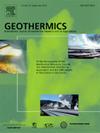Characteristics of the radiogenic heat production in granitoids from southern Tibetan Plateau: Thermal and geodynamic implications
IF 3.9
2区 工程技术
Q3 ENERGY & FUELS
引用次数: 0
Abstract
The long-lived radioactive isotopes of U, Th, and K serve as the principal heat-producing elements in rocks. Investigating the concentrations of these radiogenic elements and their associated heat production rates within the extensively distributed granitoids of the southern Tibetan Plateau not only provides important insights into the heat source mechanisms and genetic models of the widely distributed high-temperature geothermal resources in the region but also offers valuable contributions to understanding the geodynamic characteristics of the area. In this study, we systematically compiled geochemical data for granitoids from the southern Tibetan Plateau spanning several decades, resulting in a dataset of 1293 radiogenic heat production rate (RHPR) values. Representing the first systematically RHPR dataset for the southern Tibetan Plateau so far. The statistical analysis reveals average concentrations of U, Th, and K of 3.87 ± 3.99 ppm (Range: 0.11 ∼ 53.87 ppm), 18.38 ± 14.46 ppm (Range: 0.19 ∼ 118 ppm), and 3.06 ± 1.21 % (Range: 0.02 ∼ 8.03 %), respectively. The average Th/U and K/U ratios were found to be 6 ± 4.12 (Range: 0.06 ∼ 64.09) and 1.27 ± 1.03 (× 104) (Range: 0.01 × 104 ∼ 9.93 × 104), respectively. The average RHPR of granitoids from the southern Tibetan Plateau was calculated to be 2.57 ± 1.79 μW/m3 (Range: 0.05 ∼ 15.06 μW/m3), and the data display a well-defined normal distribution. The average concentrations of U, Th, K, and RHPR are lowest during the Mesozoic, with Th showing the highest average concentration in the Late Paleozoic, while the other elements peak during the Cenozoic. The Th/U ratio exhibits a gradual decline with younger geological ages, whereas the K/U ratio is highest in the Mesozoic and lowest in the Cenozoic. The spatial distribution of RHPR reveals a clear trend of gradually decreasing RHPR values from north to south across the southern Tibetan Plateau, with the Qiangtang, Lhasa, and Himalayan blocks exhibiting RHPR values of 3.1 ± 1.42 μW/m3, 2.46 ± 1.83 μW/m3, and 2.25 ± 1.84 μW/m3, respectively.
Although the RHPR values in the southern Tibetan Plateau are generally lower than those in other high-temperature geothermal fields where granitoid radiogenic heat predominates, elevated RHPR values are still observed in certain regions, such as Gonghe Basin, Cooper Basin which is located in Australia. Based on the RHPR data collected in this study and information on the enrichment layers of radiogenic heat-producing elements in the crust, the radiogenic heat contribution of granitoids to the terrestrial heat flow was estimated, The results show that the heat contribution of granitoid in the Qiangtang, Lhasa, and Himalayan blocks was estimated to be 29.4 ∼ 39.2 μW/m3, 23.6 ∼ 31.5 μW/m3, and 21.3 ∼ 28.4 μW/m3, respectively. The above results further emphasize the significant role of RHPR in granitoids in the formation of high-temperature geothermal resources in the region. Besides, the Th/U values in the southern Tibetan Plateau show significant variation, ranging from 0.06 to 64.09, with an increasing trend in data dispersion from north to south. This pattern may reflect the complex or heterogeneous magmatic processes occurring in this region. The fluctuations in K/U ratios further emphasize the intricate material migration processes within the magma source, driven by the subduction of the Indian Plate and the subsequent crustal thickening of the southern Tibetan Plateau. The elevated K/U values observed during the Cenozoic are likely the result of widespread lava flows that traversed thick, incompatible-element-enriched crustal sequences before eruption, causing chemical and isotopic mixing within the continental crust.
青藏高原南部花岗岩类放射成因产热特征:热学和地球动力学意义
U、Th和K的长寿命放射性同位素是岩石中主要的发热元素。研究青藏高原南部广泛分布的花岗岩类中这些放射性成因元素的浓度及其相关产热率,不仅为了解该地区广泛分布的高温地热资源的热源机制和成因模式提供了重要的见解,而且对了解该地区的地球动力学特征也有重要贡献。本文系统整理了青藏高原南部花岗岩类近几十年的地球化学数据,建立了1293个放射性成因产热率(RHPR)数据集。代表了迄今为止青藏高原南部第一个系统的RHPR数据集。统计分析表明,U、Th和K的平均浓度分别为3.87±3.99 ppm(范围:0.11 ~ 53.87 ppm)、18.38±14.46 ppm(范围:0.19 ~ 118 ppm)和3.06±1.21%(范围:0.02 ~ 8.03%)。平均Th/U和K/U比值分别为6±4.12(范围:0.06 ~ 64.09)和1.27±1.03(范围:0.01 × 104 ~ 9.93 × 104)。青藏高原南部花岗岩类的平均RHPR为2.57±1.79 μW/m3(范围为0.05 ~ 15.06 μW/m3),数据呈良好的正态分布。U、Th、K和RHPR的平均浓度在中生代最低,Th的平均浓度在晚古生代最高,其他元素在新生代达到峰值。Th/U比值随年龄的减小而逐渐减小,而K/U比值在中生代最高,在新生代最低。青藏高原南部地区RHPR的空间分布呈现由北向南逐渐降低的趋势,羌塘、拉萨和喜马拉雅地块的RHPR值分别为3.1±1.42 μW/m3、2.46±1.83 μW/m3和2.25±1.84 μW/m3。尽管青藏高原南部的RHPR值普遍低于其他以花岗岩类放射成因热为主的高温地热田,但在某些地区仍有较高的RHPR值,如共和盆地、澳大利亚库珀盆地等。根据本研究收集的RHPR资料和地壳中放射性成因热元素富集层的信息,估算了花岗岩类对大地热流的放射性成因热贡献,结果表明,羌堂、拉萨和喜马拉雅地块花岗岩类的热贡献分别为29.4 ~ 39.2 μW/m3、23.6 ~ 31.5 μW/m3和21.3 ~ 28.4 μW/m3。上述结果进一步强调了花岗岩类中RHPR在该地区高温地热资源形成中的重要作用。青藏高原南部Th/U值变化显著,范围在0.06 ~ 64.09之间,数据分布从北向南呈增加趋势。这种模式可能反映了该地区发生的复杂或非均质岩浆作用。K/U比值的波动进一步强调了岩浆源内部复杂的物质迁移过程,这是由印度板块俯冲和随后青藏高原南部地壳增厚所驱动的。在新生代观测到的高K/U值可能是广泛的熔岩流在喷发前穿过厚的、不相容的富含元素的地壳序列,导致大陆地壳内化学和同位素混合的结果。
本文章由计算机程序翻译,如有差异,请以英文原文为准。
求助全文
约1分钟内获得全文
求助全文
来源期刊

Geothermics
工程技术-地球科学综合
CiteScore
7.70
自引率
15.40%
发文量
237
审稿时长
4.5 months
期刊介绍:
Geothermics is an international journal devoted to the research and development of geothermal energy. The International Board of Editors of Geothermics, which comprises specialists in the various aspects of geothermal resources, exploration and development, guarantees the balanced, comprehensive view of scientific and technological developments in this promising energy field.
It promulgates the state of the art and science of geothermal energy, its exploration and exploitation through a regular exchange of information from all parts of the world. The journal publishes articles dealing with the theory, exploration techniques and all aspects of the utilization of geothermal resources. Geothermics serves as the scientific house, or exchange medium, through which the growing community of geothermal specialists can provide and receive information.
 求助内容:
求助内容: 应助结果提醒方式:
应助结果提醒方式:


